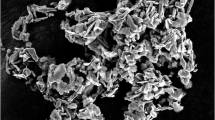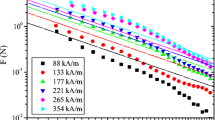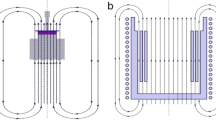Abstract
The study experimentally examines the quasi-static shear deformation of a magnetorheological (MR) fluid structured in an external magnetic field. Experiments are carried out using a rheometer with a plate–plate configuration. The working surfaces of the measuring geometry are modified to demonstrate their influence on the response of the field-structured MR fluid. The simplest possible suspension of microparticles of carbonyl iron in mineral oil without using surfactants or any modifiers is used. The difference in results obtained for structured MR fluid with different concentrations of magnetic particles using different modifications of the surface is demonstrated. The results are intended to motivate more intensive research on the issue and further more in-depth theoretical analysis of static elastic properties of structured MR fluids. Certain related critical issues are briefly highlighted.
Similar content being viewed by others
Avoid common mistakes on your manuscript.
1 Introduction
Suspensions of magnetic microparticles, called magnetorheological (MR) fluids, are well known in science and technology and have a variety of technical implementations. The application of an external magnetic field makes it possible to remotely tune physical properties of these fluids, primarily controlling their rheological behaviour. The best known commercialised applications based on MR fluids are semi-active shock absorbers and damping devices. On the other hand, MR fluids are an attractive subject for research into fundamental problems related to soft matter physics, e.g. magnetically induced pattern formation and structural transformations. The most comprehensive survey of various aspects of MR technologies is presented in a recent review [1]. A significant number of experimental studies address the rheological behaviour of MR fluids in terms of dynamics, i.e. shear flow, including creep test, and oscillating shear test see, e.g. [2,3,4]. At the same time, research into the static elastic properties of structured MR fluids is rather limited. A number of theoretical models are known to consider the quasi-static behaviour of particle structures [5,6,7]. These models are based on the analysis of rather simple structures such as linear chains or ellipsoidal and cylindrical aggregates. A recent computer simulations demonstrated the appearance of nonmonotonic dependence of the shear stress vs. macroscopic shear deformation with an overshoot at a certain deformation [8, 9]. It is obvious that in a laboratory experiment, not only microstructural effects due to particle magneto-mechanic interactions, but also the interaction of the experimental sample with the measuring geometry, influence the obtained macroscopic results. Critical aspects related to the influence of rheometer measuring cell parameters on the observed rheological response of MR fluids, including material and surface roughness of the measuring plates, are experimentally addressed in [10]. Furthermore, in [11,12,13,14], the presence of slippage of MR fluid particle structures on the measuring plates having different roughness has been demonstrated. Then, again, these studies are concerned with flow curves and yield stresses evaluation. The present work is an experimental preliminary study of the response of a MR fluid structured by an external magnetic field to stationary shear. The experiment is carried out using a rheometer in a conventional plate–plate configuration when the magnetic field is perpendicular to the shear direction. A special feature of the experiment is the alteration of the measuring geometry surfaces, which provides modified conditions of interaction between the measuring geometry and the particle structures in the fluid sample under study.
2 Experimental
2.1 Samples
In this study, suspensions based on silicone oil M10000 with a dynamic viscosity 10 Pa s (GE Bayer Silicones, Germany) and carbonyl iron powder (CC grade, BASF, Germany) with an average particle size of about 5 \(\upmu \)m were used. The highly viscous oil was chosen as a carrier liquid to counteract particle sedimentation, as no any special additives and stabilisers have been utilised. This rather simple suspension composition is due to the desire to use a sample most consistent with simplified theoretical approximations that consider the behaviour of MR fluids. The magnetic powder was thoroughly mechanically mixed with the carrier medium in three volume concentrations (5, 25 and 40%). The resulting suspension samples were continuously stirred in external vessels to maintain their homogeneity.
2.2 Setup
Measurements were conducted using the Physica MCR 502 WESP rheometer (Anton Paar GmbH, Austria) equipped with the magnetorheological device MRD [15]. As measuring geometry a non-magnetic plate–plate arrangement was utilised, at that, as a rotor the Anton Paar PP20/MRD/TI geometry was used. This is a specially designed for MRD made of Ti plate having a working surface of 20 mm in diameter combined with an additional cover. The measuring configuration is shown schematically in Fig. 1.
The surfaces of the rotating plate (rotor) and the static plate were modified in two different ways. The first modification (Fig. 2, left) is an abrasive paper with a medium grit of P400 and a thickness of \(\sim 0.5\) mm. It is referred to as P400. The layer of the abrasive paper was replaced before each new measurement. The other modification used (Fig. 2, right) is a foamed open-pored material, hereinafter referred to as the anti-slip cover (ASC), with a layer thickness of 1 mm. This material was kindly provided by Dr. W. Kordonsky of QED Technologies International, Inc (USA). The anti-slip cover was replaced and swabbed with a suitable MR fluid sample before each new measurement. This provides three different situations regarding the surface of the measuring geometry interacting with the fluid sample: unmodified polished surface, roughened surface (P400), porous surface able to absorb MR fluid (ASC).
Since the measurements are to be carried out at a measuring gap of 1 mm, a modification of measuring plates results in an increase in the distance between them. This in turn results in the measuring geometry hitting the MRD cover from the inside. A solution was implemented to raise the magnetic cover by means of a plastic ring (PLA) with a height of 3 mm. The ring compensates the gap increase reasoned by the respective modification of the plates surfaces. This modification reduces the maximum possible strength of the magnetic field generated by the MRD, but has no significant effect on field homogeneity. It is about 95% in the measuring gap (see Table 1). To measure the magnetic field strength distribution, the Hall sensor was pulled out of the slot in the MRD cell step by step and the field was measured every 2 mm.
2.3 Methods
To evaluate a quasi-stationary shear deformation of the MR fluid, the sample was first structured, i.e. disposed under magnetic field influence, for at least 5 minutes. Then the specimen under study was loaded with a constantly increasing strain from \(\gamma = 0\%\) to \(\gamma = 10\%\) and the corresponding shear stress on the moving rotor was measured. For the plate–plate arrangement with the measuring gap of 1 mm, this strain means a displacement at the edge of the moving upper plate of 0.1 mm at maximum strain. A time period of 100 s was selected and measured with 10 measuring points per second. A fresh fluid sample was used for each measurement, as the pre-shear, usually required to homogenise the MR fluid after once measured under applied field, potentially alters the initial conditions of the quasi-static experiment. As reference measurements, experiments without a magnetic field were also performed. All measurements were carried out at a temperature of \(25~^{\circ }\)C.
2.4 Results and discussion
The response to the applied quasi-static shear of all the MR fluid samples tested in the control measurements, i.e. without the use of a magnetic field, is not systematically analysed. In the zero field, the MR fluids behave like ordinary viscous bodies, which also does not induce significant shear stress as a result of quasi-static shear. The variation of shear stresses is in units of Pa. It is not possible to evaluate the influence of different surfaces on the response of an unstructured MR fluid.
The response to applied quasi-static shear of a field-structured MR fluid differs for both samples with different concentrations of magnetic particles and for different measuring geometry surfaces used. The exemplary results are shown in Figs. 3, 4 and 5 for samples with a particle volume concentration of 5, 25 and 40% respectively. An influence of the surface modification on the shear stress development under the same operating conditions within quasi-static shear is to be clearly noted.
The stress–strain curves obtained for the low-concentrated MR fluid sample in the magnetic field with the strength of 100 kA/m and 200 kA/m are qualitatively similar for the non-modified geometry and for both types of modified geometries (see Fig. 3). Nevertheless, both curves measured with modified plates are consistently below the curve obtained with plates without modification. Furthermore, the curves obtained using ASC are below the curves obtained using P400 for both field strengths. However, in a field of 200 kA/m, the curve obtained using P400 is almost equal to the curve obtained using unmodified plates. On the one hand, this result may seem controversy to the results obtained, e.g. in [11, 12], where higher stresses were observed for the modified surfaces compared to the smooth surface. But in fact, such a comparison of shear stresses would be not correct, because these works focus on shear flow. In particular in [12], yield stress values are extracted by various methods using approximations of measured flow curves and in [11] oscillating shear additionally to the shear flow is under discussion. While our study considers quasi-static shear of a structured fluid at small deformations, that is, presumably before reaching the yield stress, i.e. without a flow. Thus, it may not only be a question of the influence of measurement conditions, but also possibly of various physical processes. Nevertheless, this issue is to be addressed in further studies to provide a correct interpretation.
For the MR fluid with 25 vol.% of magnetic particles, a similar qualitative result to the suspension with 5 vol.% of particles is obtained (see Fig. 4). The first quantitative difference is that the strain–stress curve for ASC is higher than the curve for P400 at both fields. Moreover, at the field of 200 kA/m, the curve measured using the ASC is above the curve obtained using the non-modified geometry. For the highly concentrated MR fluid, the qualitative appearance of the strain–stress curves remains the same, while the quantitative situation changes further. The curves obtained using ASC and P400 run above the curve obtained for the unmodified surface for both fields. In general, it is evident that changing the interaction conditions of the structured suspension with the surface of the measuring geometry dramatically affects the experimental observation result. The qualitative appearance of all the curves suggests that there could be a slippage of the particle structures over the geometry surfaces and/or particle structures are still intact (not destroyed) even at a maximum applied strain of 10%. The later reason seems to be possible taking into account simulating results reported in [9], where critical shear strain is in between 10 and 20% thought at saturation field. On the other hand, we observe different quantitative values of the shear stress with variations in the type of surface of the measuring geometry and variations in the fluid concentration. Therefore, the assumption of local slippage of particle structures relative to the plate surface, presumably taking place in the experiment, is also quite reasonable. The different results obtained for different suspension concentrations and magnetic field strengths can be explained by the fact that the morphology of the particle structure also differs in these cases. The dependence of the microstructure morphology in magnetic composites on particle concentration and field strength has been demonstrated, for example, in experiments [16, 17]. At low concentrations of magnetic filler, one may deal with chain-like aggregates, while in concentrated suspensions, labyrinth-shaped and wall-like clusters may occur. Accordingly, aggregates with different morphology interact in different ways with different kinds of measuring geometry surfaces, which leads to variations in the results obtained.
Furthermore, it should be noted that the effective working gap for different modifications of the measuring geometry surface may in fact be different, due to different surface roughness. Accordingly, the actual strain acting on the structured MR fluid will also be different. The condition of filling the gap with the investigated specimen is also extremely important. As visual inspection of the sample during measurement is not possible, it cannot be ensured that the sample remains in the working gap borders. This is a known problem in the case of MR fluids shear flow.
In summary, it is not possible to make precise and reliable statements about the actual behaviour of the particle structures through these preliminary experiments. More detailed study is necessary to accurate assessment of the issue. The main aim of this preliminary work was to demonstrate the influence of the measuring geometry surface on the experimental results. Obviously, when comparing the results of theoretical work with the real experiment, it is necessary to take into account this factor, which significantly affects at least the quantitative results.
It is also crucial to make the following critical point about the experimental results published for MR materials. Commercial magnetic cells offered for commercial rheometer represent a kind of black boxes designed for general macroscopic characterisation of MR materials. In particular, they are aimed at estimating the apparent yield stress of MR fluids in the context of their use in damping applications. In that case, we are talking about solving engineering problems and not about precise physical measurements related to fundamental research and detailed microscopic understanding of the material behaviour. In this regard, experimental results obtained using such devices should be not over-interpreted and assessed very critically.
3 Outlook
In addition to a deeper systematic study of the influence of the above parameters on the response of the structured MR fluid in the quasi-static shear test, the following should also be considered. For example, it is not clear how the roughness of the measuring geometry influences the gap height and in general the relation of the gap height to the structuring effect in MR fluids in the context of the quasi-static shear. Studies should be conducted with higher shear strain, when the particle structures in the MR fluid are guaranteed to rupture. In this case, it will be possible to make at least qualitative comparisons with known theoretical predictions and simulating representations and to draw conclusions about the mechanism of fluid behaviour.
References
J. Morillas, J. de Vicente, Soft Matter 16, 9614–9642 (2020)
G. Bossis, O. Volkova, S. Lacis, A. Meunier, in Ferrofluids Magnetically Controllable Fluids and Their Applications, ed. by S. Odenbach (Springer, Berlin, 2002)
Z. Wang, K. Shahrivar, J. de Vicente, J. Rheol. 58, 1725–1750 (2014)
N. Wereley (ed.), Magnetorheology (RSC Publishing, Cambridge, 2014)
G. Bossis, E. Lemaire, O. Volkova, J. Rheol. 41, 687 (1997)
G.J. Hiemenz, Y.T. Choi, N.M. Wereley, AIAA J. Aircr. 44, 1031 (2007)
D. Borin, D. Chirikov, A. Zubarev, Sensors 18, 2054 (2018)
A. Zubarev, D. Chirikov, D. Borin, J. Magn. Magn. Mater. 498, 166129 (2020)
A. Zubarev, D. Chirikov, D. Borin, Eur. Phys. J. Spec. Top. 229, 2967–2979 (2020)
E. Lemaire, G. Bossis, J. Phys. D Appl. Phys. 24, 1473 (1991)
A. Gomez-Ramirez, M.T. Lopez-Lopez, F. Gonzalez-Caballero, J.D.G. Duran, Rheol. Acta 51, 793–803 (2012)
I. Jonkkari, E. Kostamo, J. Kostamo, S. Syrjala, M. Pietola, Smart Mater. Struct. 21, 075030 (2012)
J. Caballero-Hernandez, A. Gomez-Ramirez, J.D.G. Duran, F. Gonzalez-Caballero, A.Yu. Zubarev, M.T. Lopez-Lopez, Appl. Rheol. 27, 15001 (2017)
R. Wu, H. Tang, Y. Fu, J. Zheng, H. Lin, H. Huang, S. Chen, J. Intel. Mat. Syst. Struct. (2021). https://doi.org/10.1177/1045389X211014953
J. Laeuger, K. Wollny, H. Stettin, S. Huck, Int. J. Mod. Phys. B 19, 1353–1359 (2005)
D. Günther, D. Borin, S. Günther, S. Odenbach, Smart Mater. Struct. 21, 015005 (2012)
D. Borin, Philos. Trans. R. Soc. A 378, 20190256 (2020)
Acknowledgements
D.B. would like to acknowledge the financial support by the Deutsche Forschungsgemeinschaft (DFG) under Grant Bo 3343/3-1 within PAK 907. A.Z. thank the Russian Fund of Fundamental Investigation, Grants 19-31-90003; 19-52-45001; 21-52-12013 and as well as the Program of the Ministry of Science and Education of Russian Federation, project FEUZ-2020-0051.
Funding
Open Access funding enabled and organized by Projekt DEAL.
Author information
Authors and Affiliations
Corresponding author
Rights and permissions
Open Access This article is licensed under a Creative Commons Attribution 4.0 International License, which permits use, sharing, adaptation, distribution and reproduction in any medium or format, as long as you give appropriate credit to the original author(s) and the source, provide a link to the Creative Commons licence, and indicate if changes were made. The images or other third party material in this article are included in the article’s Creative Commons licence, unless indicated otherwise in a credit line to the material. If material is not included in the article’s Creative Commons licence and your intended use is not permitted by statutory regulation or exceeds the permitted use, you will need to obtain permission directly from the copyright holder. To view a copy of this licence, visit http://creativecommons.org/licenses/by/4.0/.
About this article
Cite this article
Borin, D., Spörl, E.M., Zubarev, A. et al. Surface influence on the stationary shear deformation of a magnetorheological fluid. Eur. Phys. J. Spec. Top. 231, 1159–1163 (2022). https://doi.org/10.1140/epjs/s11734-022-00527-4
Received:
Accepted:
Published:
Issue Date:
DOI: https://doi.org/10.1140/epjs/s11734-022-00527-4









